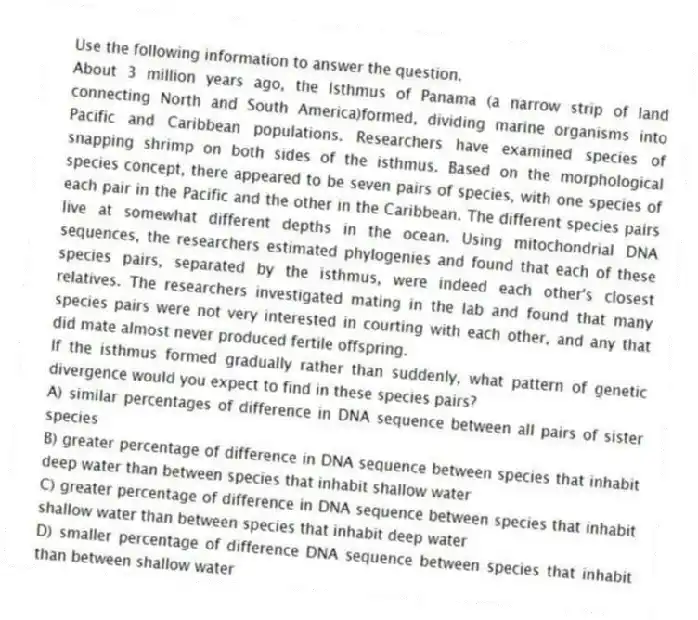
Use the following information to answer the question.
About 3 million years ago, the Isthmus of Panama (a narrow strip of land connecting North and South America) formed, dividing marine organisms into Pacific and Caribbean populations. Researchers have examined species of snapping shrimp on both sides of the isthmus. Based on the morphological species concept, there appeared to be seven pairs of species, with one species of each pair in the Pacific and the other in the Caribbean. The different species pairs live at somewhat different depths in the ocean. Using mitochondrial DNA sequences, the researchers estimated phylogenies and found that each of these species pairs, separated by the isthmus, were indeed each other's closest relatives. The researchers investigated mating in the lab and found that many species pairs were not very interested in courting with each other, and any that did mate almost never produced fertile offspring.
-If the isthmus formed gradually rather than suddenly, what pattern of genetic divergence would you expect to find in these species pairs?
A) similar percentages of difference in DNA sequence between all pairs of sister species
B) greater percentage of difference in DNA sequence between species that inhabit deep water than between species that inhabit shallow water
C) greater percentage of difference in DNA sequence between species that inhabit shallow water than between species that inhabit deep water
D) smaller percentage of difference DNA sequence between species that inhabit than between shallow water
Correct Answer:
Verified
Q16: The peppered moth provides a well-known example
Q23: How are two different species most likely
Q24: In the oceans on either side of
Q24: You want to study divergence of populations,
Q25: Two species of tree frogs that live
Q26: Two researchers experimentally formed tetraploid frogs by
Q28: Most causes of speciation are relatively slow
Q28: In the oceans on either side of
Q31: House finches were found only in western
Q32: The difference between geographic isolation and habitat
Unlock this Answer For Free Now!
View this answer and more for free by performing one of the following actions

Scan the QR code to install the App and get 2 free unlocks

Unlock quizzes for free by uploading documents